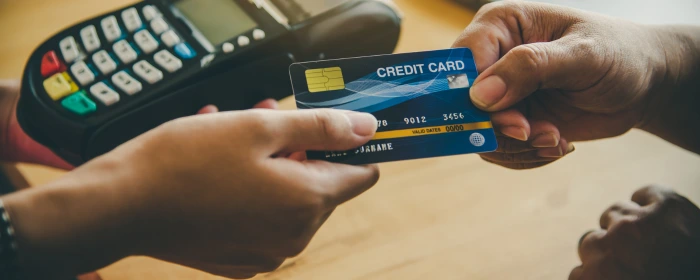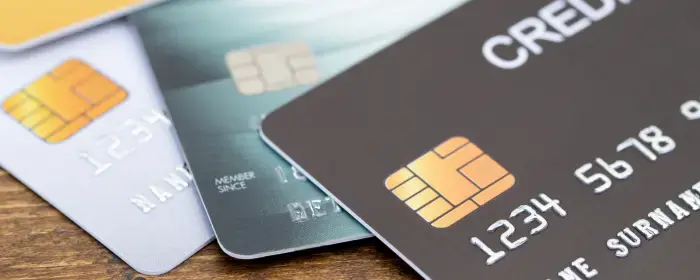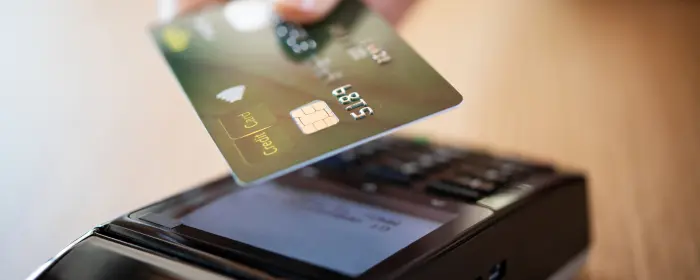Accepting payments from customers is the backbone of your business's revenue. Modern payment processing tools make it simple for businesses to set up online and in-person credit card processing. However, while business owners no longer need technical know-how to accept credit card payments, not understanding credit card processing and how it works leads to payment shortcomings. Likewise, it results in many business owners overpaying for credit card transactions.
This guide explores processing credit cards, the participants in the process, the factors to consider when choosing a payment processor, credit card transaction fees, and a range of related topics. Read ahead to become an expert on modern payment processing!
What Is Credit Card Processing?
Processing credit cards is the electronic handling of credit card transactions. It involves the authorization, authentication, and settlement of payments. Credit card processing enables businesses to accept payments from customers using credit cards, ensuring payment convenience for customers and staff members. Modern payment processing offers efficiency, speed, and security. It enables swift transactions, reducing processing times. Enhanced security features like encryption and tokenization protect sensitive information, and integration with digital platforms fosters seamless transactions, improving user experience.
Who Is Involved in the Process?
While credit card payments occur almost instantly, behind the scenes is a complex network of stakeholders responsible for performing various tasks to ensure the transaction runs smoothly. The transaction process is automated and occurs without manual input, but to fully understand how payment processing works, it's essential to know which stakeholders are involved. Below, let's explore who is involved in the process:
- Customer (Cardholder): The cardholder purchases goods or services from a business with a credit card.
- Merchant: The merchant is the business receiving payment for goods or services.
- Payment Processor: The payment processor connects the various stakeholders — it transmits payment data between merchants and banks to ensure smooth and efficient transactions.
- Acquiring Bank: Acquiring banks, also known as acquirers, are financial institutions that process credit or debit card transactions on behalf of merchants. They facilitate the transfer of funds from the customer's issuing bank to the merchant's account.
- Card Network: Card networks, also known as card brands, are credit card companies that provide standards and processes for transacting card payments. Popular examples include Visa, Mastercard, and American Express. Each card brand has its logo, policies, and network, and it collaborates with issuing banks, acquiring banks, and credit card processors to facilitate electronic payments globally.
- Issuing Bank: Issuing banks are the institutions issuing customers credit and debit cards. They authorize transactions, ensure funds are available, and manage accounts.
How Does Credit Card Processing Work?
While credit card transactions feel instantaneous to merchants and customers, they involve a multi-stage process. Below, let's explore the three stages of credit card processing in more detail:
Authorization
The authorization stage of payment processing involves verifying if a transaction is valid and whether a customer has the available funds for a purchase. This process involves the payment processor requesting approval from the issuing bank. If the issuing bank communicates that the transaction is invalid or the customer doesn't have sufficient funds, the transaction will decline.
Authentication
Next, it's time to confirm the identity of the cardholder. Credit card processors will use security measures, such as CVV, zip code confirmation, and more, to determine whether the cardholder is the individual purchasing the product or service. Again, the transaction will decline if the authentication process fails due to incorrect information.
Settlement
Lastly, it's time to finalize the transaction and transfer the funds. The payment processor submits approved transactions for payment and funds transfer from the issuing bank to the business's merchant account.
Types of Credit Card Processing Equipment
To accept credit card transactions, businesses require hardware and software to facilitate the process. Below, let's explore the various types of credit card processing equipment and software your business may want to consider:
POS Systems
Point-of-sale (POS) systems are an all-in-one solution for accepting in-person payments. In decades past, POS systems were simple cash registers, but modern systems involve advanced software, credit card payments, and other modern payment solutions. POS systems allow businesses to accept payments, track customer order history, offer rewards, and more. Some POS systems run on traditional computers or tablets (such as PCs and iPads), while others have dedicated hardware supplied by the POS provider.
Countertop Terminals
If you need the functionality of a POS system without any clunky hardware, a countertop terminal is the perfect solution. As their name suggests, countertop terminals rest on countertops, making it simple for customers to tap, insert, or swipe credit cards. Many countertop terminals also have interactive screens, allowing customers to sign, enter PINs, request receipts, and more.
Mobile Card Readers
Mobile card readers revolutionized the way many businesses accept payments. With a mobile card reader, merchants connect a card reader to a mobile device via Bluetooth or traditional cable. Merchants download a POS app, which allows them to control the card reader. This technology fosters flexibility, allowing transactions to occur anywhere and boosting sales on the go. The device's portability facilitates transactions without the constraints of a fixed location.
Payment Gateways and Virtual Terminals
Payment gateways and virtual terminals empower your business to accept card-not-present transactions. To offer your customers ultimate payment convenience, offering more than in-person payments is critical. Payment gateways are online portals, usually integrated into eCommerce stores, allowing customers to input their credit card details to process transactions. Many payment gateways offer extra features to provide added convenience for customers, such as saving credit card details for future use.
On the other hand, virtual terminals allow staff members to input customer credit card details to process payments. This payment tool is designed for accepting payments over the phone or via email when a customer can't visit a physical retail store.
Understanding Credit Card Processing Fees
Credit card processing fees are among the first factors to consider when choosing a new payment processor. However, there are various fees and pricing models to consider when comparing processing rates. Payment processing fees are projected to rise in 2024, and without understanding these fees and pricing models, you may overpay for credit card processing and damage your margins. First, let's look at the most common fees levied by credit card processors:
- Processing/Transaction Fees: This is a fee charged per transaction. It's usually a percentage of the transaction value but may also include a fixed rate per transaction.
- Monthly Fees: Some payment processors charge monthly subscription fees, regardless of the volume of payments your business processes.
- Chargeback Fees: When customers file chargebacks against your business, most credit card processors charge fees to recoup their losses (in addition to your business refunding the order total to the cardholder).
- Return Fees: If a customer returns an item, payment processors may charge fees to recoup any losses from the transaction.
- International Transaction Fees: International transactions typically incur additional fees, making it less attractive to accept credit cards from customers abroad.
- Gateway Fees: Payment gateway providers often charge a small commission for using gateways for payment authentication.
- Early Termination Fees: If a payment processor requires a long-term contract, they may charge early termination fees if you move to another provider.
Now that you understand the various fees processors charge merchants, it's time to look at payment processing fee pricing models. There are three major pricing models:
- Flat-Rate Pricing: With flat-rate pricing, your business pays the same rate for payment processing regardless of card brand. However, pricing will still vary for different types of payments (i.e., there will usually be a separate transaction fee for online and in-person payments).
- Tiered Pricing: Tiered payment pricing categorizes transactions into tiers, each with a predefined rate. These tiers often include qualified, mid-qualified, and non-qualified levels (based on factors like transaction type and risk). The simplicity may result in merchants paying different rates for similar transactions.
- Interchange-Plus Pricing: Interchange-Plus pricing is usually the most affordable pricing model. It charges merchants the interchange fee plus a pre-defined markup from the payment processor. This provides transparency and ensures payment service providers aren't hiding excessive fee hikes.
What to Know About PCI Compliance
When selecting a payment processor, merchants must prioritize Payment Card Industry Data Security Standard (PCI DSS) compliance. PCI DSS ensures secure handling of credit card information to prevent data breaches. Merchants should choose processors compliant with PCI DSS standards, reducing liability and enhancing customer trust. Verify the processor's compliance status, ensuring they adhere to the latest requirements.
What to Consider When Choosing a Credit Card Processing Provider
While changing payment processors in the future is possible, choosing the best merchant service provider from the outset will save your business time and money. Understanding a few critical factors will help your business choose the best partner for credit card payments:
Merchant Account vs. Payment Aggregator
A merchant account is preferable to a payment aggregator due to greater control and customization. Merchants with their accounts have more flexibility in managing transactions, personalizing branding, and negotiating fees. It reduces the risk of sudden account holds or terminations. Additionally, a dedicated merchant account offers a direct relationship with acquiring banks, potentially resulting in better support and tailored solutions, making it a more reliable and scalable choice for businesses with substantial transaction volumes. Payment aggregators offer quicker access to payment processing services, but many merchants using payment aggregation face unexpected account closures, slow funding timeframes, excessive fees, and other issues.
Integration Capabilities
It's essential to choose a payment processor with third-party software platforms, such as accounting software, customer relationship management (CRM) software, and more. It facilitates seamless data synchronization, allowing merchants to access comprehensive insights and analytics. Ultimately, this synergy between payment processing and third-party software optimizes business processes, making operations more efficient and adaptable to evolving market demands.
Security and Fraud Protection
Choosing a payment processor with robust security and fraud prevention measures is critical to safeguarding sensitive financial information and maintaining customer trust. Effective security protocols protect against data breaches, identity theft, and unauthorized transactions, preventing potential financial losses and reputational damage. A reputable payment processor employs encryption, tokenization, and advanced fraud detection tools to create a secure transaction environment.
Customer Support
A merchant must prioritize assessing a payment processor's customer support because seamless and responsive assistance is crucial in resolving payment issues promptly. Timely support ensures uninterrupted transactions, minimizes potential revenue loss, and enhances customer satisfaction. In the dynamic realm of commerce, unforeseen challenges like transaction disputes or technical glitches demand swift access to support.
Small Business Credit Card Processing: Final Thoughts
Credit cards and other digital payments continue to play an increasing role in the world's payment landscape, with cash payments now representing less than 20% of payments in the United States. Regardless of your business's industry, accessing affordable payment processing helps reduce overhead and improve cash flow. Likewise, a reliable payment processor makes it easier to avoid payment outages, fund freezes, and other transaction pitfalls.
While there's no shortage of payment processors available to modern merchants, many offer payment aggregation services, which provide reduced control over your business's payment infrastructure. The most reliable way to access affordable and dependable payment services is through a merchant service provider (MSP). MSPs provide access to dedicated merchant accounts and offer dedicated support, affordable processing fees, custom features, and third-party software integration!
Frequently Asked Questions (FAQs)
EMV card payments use a microprocessor chip embedded in the card to enhance security. Instead of relying solely on the magnetic stripe, the chip generates a unique transaction code for each purchase, making it significantly more difficult for thieves to counterfeit cards. When an EMV card is used for payment, the chip interacts with the card reader to create a one-time authorization code, reducing the risk of fraudulent transactions compared to traditional magnetic stripe cards. EMV chips are becoming the industry standard for credit card payments. In 2015, card networks shifted liability for magstripe-related fraud onto merchants, meaning non-EMV payments became financially risky for businesses. The result has been a near-total adoption of EMV cards in the country (and many other places worldwide).
No, merchant accounts are not required for credit card processing, but they offer merchants a range of benefits. There are now payment service providers and other payment aggregators that group multiple merchants onto a single merchant account. While this ensures businesses can access payment processing without a dedicated merchant account, it has many downsides. Businesses without a merchant account face higher processing costs, unexplained account freezes, a lack of dedicated customer support, and other issues.
Level 1, 2, and 3 credit card processing refers to the "tiers" in the tiered pricing model: the higher the tier, the safer the transaction. This means Level 3 payments usually carry lower interchange fees than Level 1 and 2 payments. Let's explore each payment tier in more detail:
- Level 1: This is a traditional consumer payment, such as an online payment, that only includes a small amount of payment data. This data may include order total, card number, CVV number, and customer zip code.
- Level 2: This is a more detailed transaction, usually a B2B transaction; it includes additional information, such as customer codes.
- Level 3: This is the most detailed transaction, usually B2B. Level 3 transactions may include extensive data, such as order volumes, product types, tax codes, etc.
As a rule of thumb, merchants should allow card transactions two to four business days to process. Some payment service providers (PSPs) offer immediate access to funds from payments for an additional fee. While this might be a valuable tool for accessing immediate cash flow, in the long run, the cost is excessive.
Credit card processing costs vary significantly depending on the payment setting, payment processor, and other factors. The best way to determine how much payment processing will cost your business is to speak with a merchant service provider. Using a merchant account is likely the most affordable payment processing option, as it provides access to Interchange-Plus pricing. While flat-rate pricing may appear more convenient, it usually hides huge markups from payment processors.
The cheapest way to take card payments varies depending on your business, its industry, and your access to various payment solutions. For many businesses, a merchant account is the cheapest method for accepting card payments. Many merchant account providers use Interchange-Plus pricing, a pricing model where merchants pay the actual interchange fees set by card networks plus a fixed markup by the payment processor. Unlike flat-rate pricing, which hides the payment processor's markup, Interchange-Plus pricing's transparency ensures cost-effectiveness for business owners.






